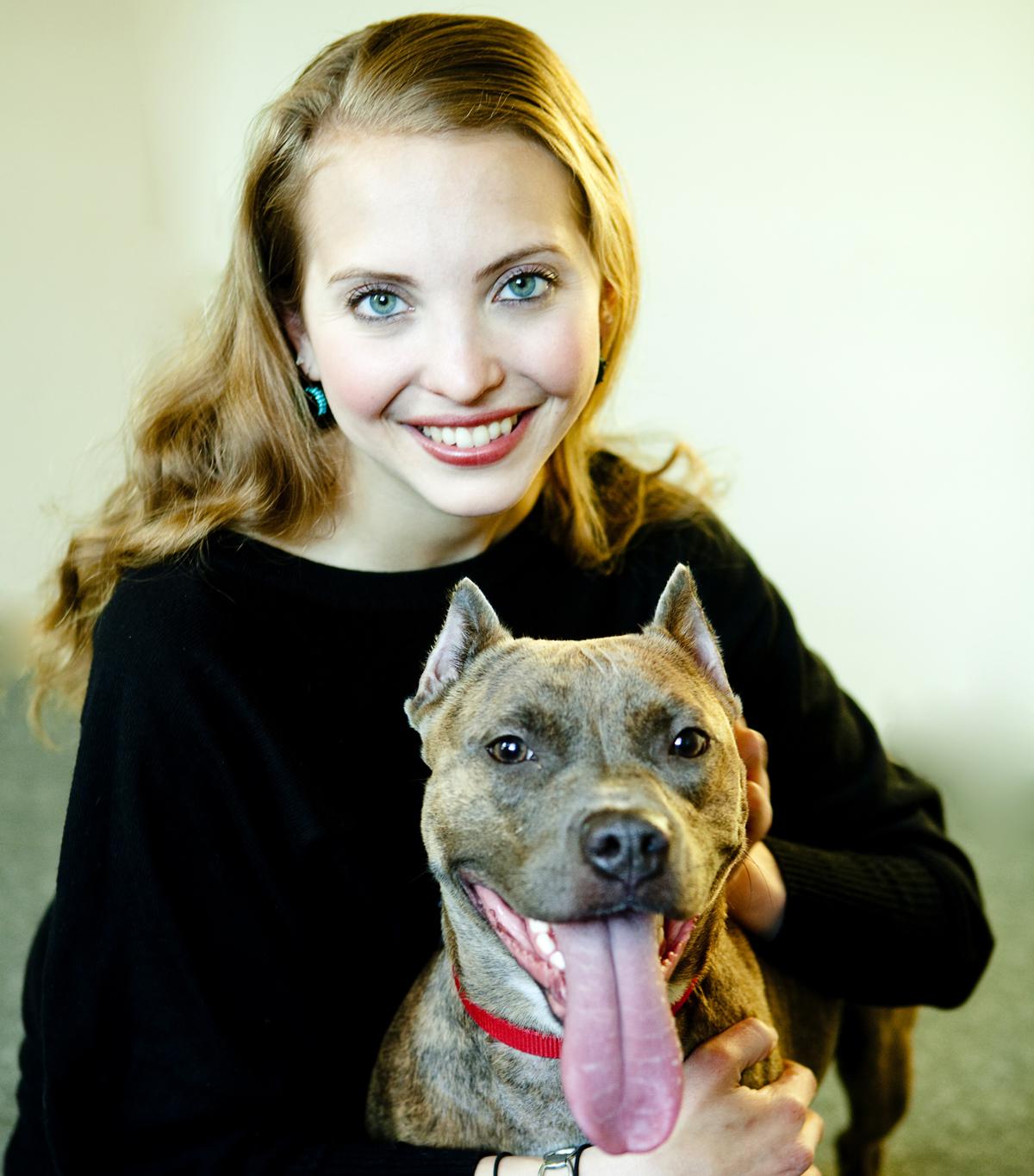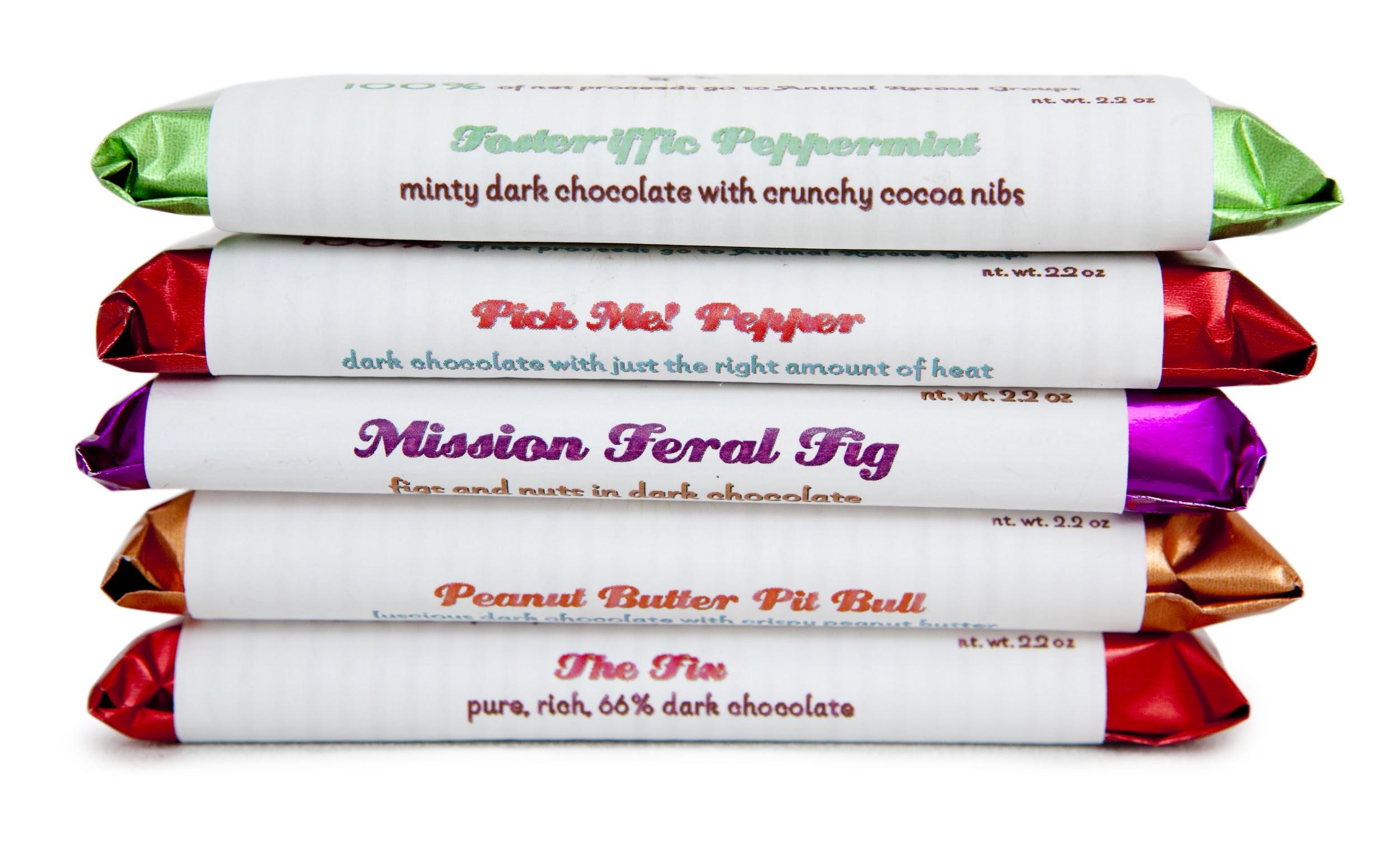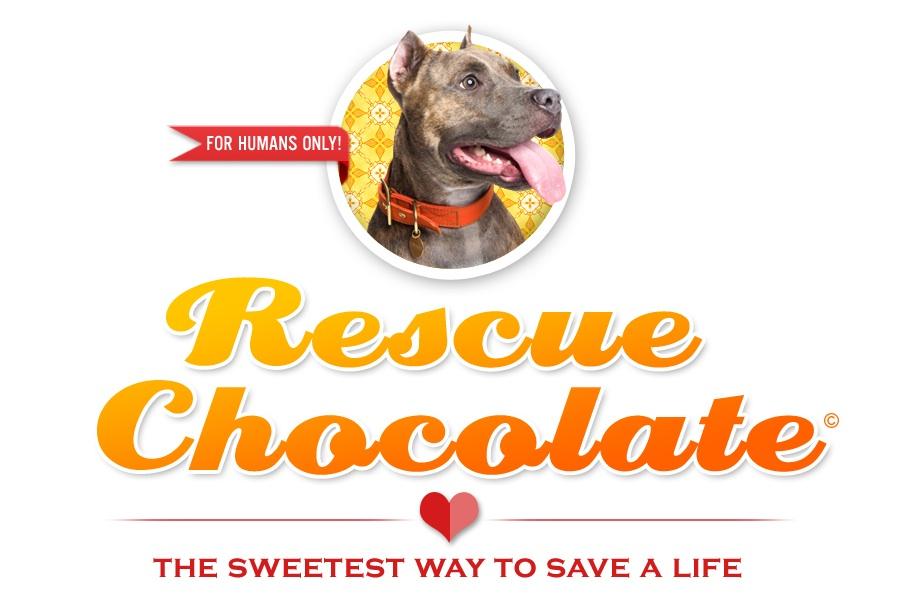Selling Dog-Themed Chocolate and Donating All Profits to Animal Rescue
Hello! Who are you and what are you working on?
I’m Sarah Gross Feoli, the founder and owner of Rescue Chocolate. While our products are only for humans to enjoy, we donate all profits to various animal rescue organizations. I began the company in January 2010, and in the past 8 years have partnered with hundreds of different rescue groups on fundraising.

All of our chocolate bars and truffles are vegan, fairly traded, organic, handcrafted in small batches in Brooklyn NY, and delicious. Each flavor highlights a different issue important in the realm of animal rescue. For example, Peanut Butter Pit Bull calls attention to the fallacies of breed-specific legislation. The Fix urges people to spay and neuter their dogs and cats as the most important step in reducing the numbers of homeless animals. There are links on our website where our customers can get more information about these issues.
Our retail customers are chocolate aficionados, animal lovers, local foodies, and anyone with a sweet tooth. On the wholesale side, we are carried at gourmet groceries, pet stores, veterinarian offices, vegan shops, and natural food stores.
What's your backstory and how did you come up with the idea?
I’ve always been interested in animal welfare, and grew up with at least one or two dogs in the house at all times. During middle school and high school, I volunteered at my local animal shelter in Shreveport, Louisiana. I also became a vegetarian and then a vegan during those years. (I chose the vegan lifestyle primarily out of compassion for animals. Later I learned that it is also beneficial to the environment and one’s health as well.)
My love for chocolate didn’t happen until my mid 20s, after I had moved to New York. I enjoyed visiting the artisan chocolatiers in the city and sampling exotic varieties. For a short time, I worked at a raw vegan chocolate factory in Queens where I developed a best-selling flavor.
Then I adopted a homeless pit bull.
One day when I was walking her in the park, I got the brainstorm to put my two passions together.
Rescue Chocolate was born, and started turning a profit in the second month of its existence. I had no business background. In fact, I had been a professional ballet dancer in college. But I learned the business basics on the fly. It helped that I did not have to set up my own factory and train my own employees. I use a co-packer, and I can run my ideas through the executive chef there.

Describe the process of designing, prototyping, and manufacturing the product.
When coming up with flavors for the bars, I usually just go with what I like. Occasionally I’ll run a very informal focus group or online survey to get input from others. I pay attention to trending ingredients. For example, for awhile there was a bacon craze. You were finding bacon in every kind of dish from entrees to desserts. I came out with a soy-bacon chocolate bar called Fakin’ Bacon. Another example is artisan salt. My Mission Feral Fig bar contains one called fleur de sel. My line of Like White bars and truffles contains chia seeds and other "superfood" ingredients. I don’t go this route only to get in on fads but also because all these ingredients are really tasty!
My husband is a graphic designer, so he is responsible for the branding and the look of the products and the website. My pit bull is the company mascot, so her photo appears on almost every label. The bars are wrapped in colorful metallic foil with a white paper oversleeve, which allows for a fun yet luxurious look.
I found my manufacturer through a chocolate consultant. Yes, there really are such people. The relationship has been great over the years. The co-packer is convenient to me in Brooklyn, and is fairly flexible in accommodating my manufacturing runs.
There were very few start-up costs. I put the initial outlay for the first run on my credit card. Since this is a sole proprietorship, I did not have any legal fees for setting up the structure. I do pay for liability insurance, to which riders are attached each time I go out to food festivals and sell direct to the consumer. When I outgrew the storage space at the factory, I rented out a small storage facility. This is where I do all the packing and shipping. (Someone else might be able to operate out of their home, but I don’t trust myself to have all that chocolate stock at my fingertips!)

Describe the process of launching the online store/business.
To create a website, I used one of the templates on Shopify. I then had a series of designers customize the look. I can add and subtract products, change prices, offer various discounts, and track where the sales are coming from, all very easily. In the beginning, I paid a photographer friend of mine to take mouth-watering shots of the chocolate; now I can do that on my own.
Originally, I used Paypal to process payments. Then Shopify created a system of its own, which I use for the online sales. I still do some invoicing of wholesale customers through Paypal. For email blasts, I like Mailchimp. Our e-newsletters go out a couple of times per month, and they have a very upbeat vibe.
Aside from the cost of goods sold, the biggest cost for running the business was and remains postage. Sometimes people don’t understand why they have to pay shipping, since Amazon and the other big players offer it for free. But I don’t do the kind of volume where that makes sense. When people pay for shipping, that means there is more money available for me to send to the animal rescue beneficiaries. Shipping gets pretty expensive in the warm-weather months, because I have to express-ship with ice packs and insulation. Therefore, sales do tend to slow way down in the summertime.
I launched in the days before Facebook had its draconian algorithms in place. Every time I got a "like" I could be sure that new people were learning about Rescue Chocolate. It doesn’t work like that anymore, so probably advertising would be an important component of launching a business today.
Since launch, what has worked to attract and retain customers?
I post on social media platforms as often as possible. The e-newsletter is particularly effective, especially when it includes a discount for loyal customers. Getting our name out in mainstream/traditional media is helpful too. I try to respond to all media requests for quotes or articles. Rescue Chocolate is also able to appear as a sponsor for many festivals and fundraisers if I make an in-kind donation of chocolate.
We also have 2 specific ways of spreading our message when we partner with rescue groups. The groups then take it upon themselves to do the marketing for us, because it benefits them. One method is similar to the Girl Scout Cookie model. We sell our chocolate to the group at below-wholesale rates. They then resell to their own supporters at the regular retail rate, keeping the difference. The second method invites all the groups’ supporters to order Rescue Chocolate online, and indicate the name of their rescue group at check-out. We give the group $1 back for each bar ordered that way.
Even without a storefront, I like to sell to customers in person at various pop-ups and events. Not only does this lead to sales on the spot, but my booth will always have an email sign-up sheet so that I can continue to contact those people and close sales down the road.

How are you doing today and what does the future look like?
Rescue Chocolate has been profitable from the very beginning. However, as with most food items, our margins are not very large. When we add in the mandate to donate a portion of every sale to charity, the margin gets squeezed even further. People know they can get mass-produced chocolate at the big-box stores very cheaply, so not everyone is willing to spend more for higher quality. Our fair-trade and organic certifications are fairly pricey, and the market simply will not bear increasing the price of a 2-ounce chocolate bar to compensate fully. For these reasons, we are not in distribution. There is not enough room in the model to pay a distributor.
About half of our sales are online, and the other half is wholesale. We have drop-ship arrangements with a few other online sellers (that specialize in either vegan products or pet-related products). We are no longer available on Amazon or in Whole Foods. In the past, we did bow down to those giants and tried to play by their rules. But we found that the few pennies we earned did not justify the headaches of dealing with them.
We plan to continue to expand gradually so that we can keep the focus on a quality product and on raising money for even more grassroots animal welfare groups. At the moment, we only ship to customers in the United States. If we can find a non-exorbitant shipping option, we would like to ship internationally as well.
Through starting the business, have you learned anything particularly helpful or advantageous?
The hardest thing to get right is inventory.
While our co-packer is known for accommodating small runs, sometimes we would prefer to order even less of a certain flavor than is possible. In trying to meet the factory’s minimums, we might wind up with too much of a perishable product at a slow time of year. Conversely if we try to compensate for that and don’t insure the next run in time, we might find ourselves with dozens of orders that we can’t fulfill.
From time to time we have hosted student interns. For the most part, I’d advocate not doing so. Even though these are not paid positions, the amount of training time they required--and the mental space to worry about them--turned out to be a net loss. Except for the very first intern I ever had! He was a firebrand from Lyon, France. He brought in quite a few new customers. I hadn’t realized at the time that he was the exception to the rule.
We make our animal welfare donations every month, and that is a way of erasing the negatives. Even if our profits are way down for a given period, at least we know we are still making a positive difference in the world.
What platform/tools do you use for your business?
Shopify provides the forward-facing website and a simple back end. The only 3rd party app I use regularly is Converso which is fairly good at convincing abandoned carts to return by utilizing a small automatic discount. For shipping I really like Ordercup which is fully integrated with Shopify and can find the cheapest shipping method for any size order. As noted above, Mailchimp does my email blasts. I also like good old Google Alerts for keeping on top of the trends in the chocolate business as well as for finding media mentions of Rescue Chocolate. And unbelievably, my accounting is all done on Excel.
What have been the most influential books, podcasts, or other resources?
My inspirations are not specifically related to my chocolate business but to my life in general, of which the business is a big part.
An early influence in my understanding of what happens to unwanted animals in this country was the No Kill Advocacy Center website. The director, Nathan Winograd, pioneered strategies for getting the kill rate way down at animal control facilities all over the country. (There used to be 18 million dogs and cats killed every year in America. Now the number is down to 4 million.) He shares his innovative ideas through conferences and on-site visits. He and other people like him give me hope that the problem can be completely solved one day, through all kinds of incremental efforts. My contributions through Rescue Chocolate are small but important.
For me, a ground-breaking book on the health benefits of a vegan lifestyle was The China Study by T. Colin Campbell. Since it was first published back in 2005, there have only been more and more scientific studies adding to the chorus. This continues to validate my decision to sell a vegan food product such as dark chocolate.
Influential podcasts are: The Tim Ferriss Show (along with Ferriss’s book The Four Hour Work Week),This Week In Startups (which is a very current insider look at startups), and How I Built This (for continued inspiration).
Advice for other entrepreneurs who want to get started or are just starting out?
Be bold.
You don’t have to know every last detail of running a business before you launch. You can learn on the job. Even if you have the best MBA credentials in the world, there will still be problems that arise that can only be straightened out using common sense.
Find something that you are passionate about, and keep that fire burning underneath all of your everyday activities. Your passion will drive you to increase sales, and master bookkeeping chores, and make cold calls, and do whatever else it is that you might not otherwise care for. Going through the motions as a disinterested automaton might work when you’re somewhere in the middle of the corporate hierarchy, but it doesn’t work at all when you are running your own business.

Where can we go to learn more?
- www.rescuechocolate.com/
- www.facebook.com/rescuechocolate/
- twitter.com/rescuechocolate
- www.instagram.com/rescuechocolate/
- Email: info@RescueChocolate.com

Download the report and join our email newsletter packed with business ideas and money-making opportunities, backed by real-life case studies.

Download the report and join our email newsletter packed with business ideas and money-making opportunities, backed by real-life case studies.

Download the report and join our email newsletter packed with business ideas and money-making opportunities, backed by real-life case studies.

Download the report and join our email newsletter packed with business ideas and money-making opportunities, backed by real-life case studies.

Download the report and join our email newsletter packed with business ideas and money-making opportunities, backed by real-life case studies.

Download the report and join our email newsletter packed with business ideas and money-making opportunities, backed by real-life case studies.

Download the report and join our email newsletter packed with business ideas and money-making opportunities, backed by real-life case studies.

Download the report and join our email newsletter packed with business ideas and money-making opportunities, backed by real-life case studies.













